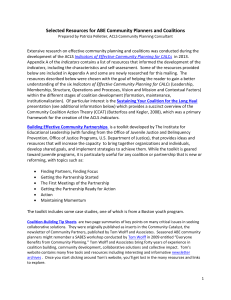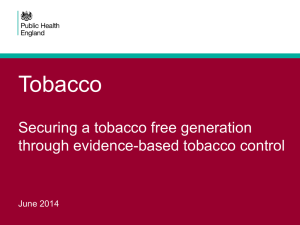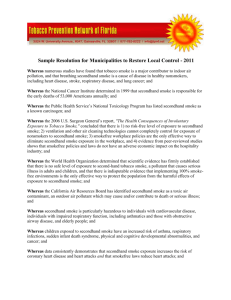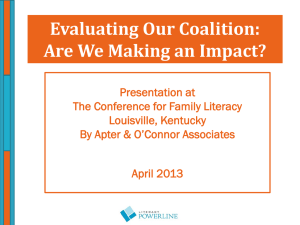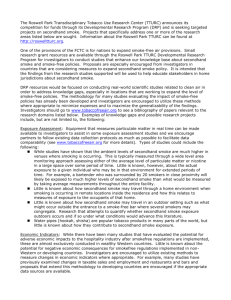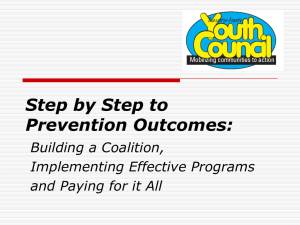Building Blocks: Collaborating for a Successful
advertisement
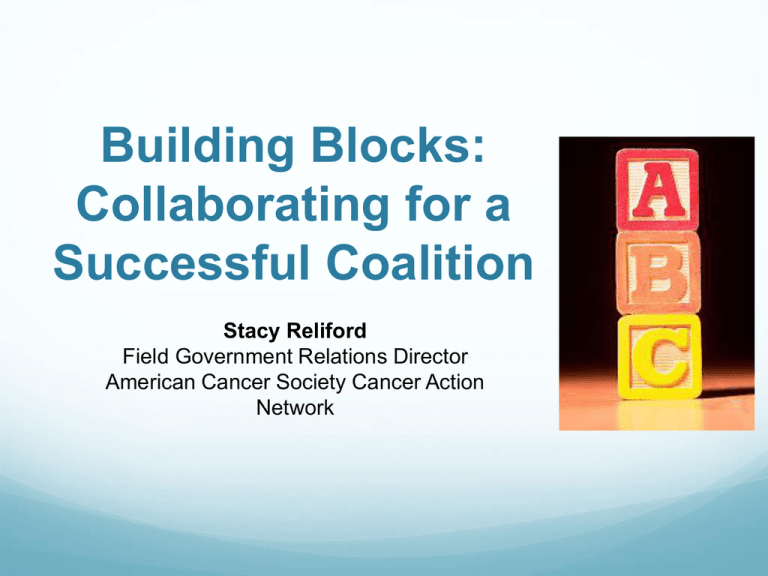
Building Blocks: Collaborating for a Successful Coalition Stacy Reliford Field Government Relations Director American Cancer Society Cancer Action Network Overview Forming your coalition Strategizing for success Recruitment & Retention Media: Read all about it! Forming Your Coalition Identify potential partners supportive of your cause Healthcare providers – nurses, doctors Public health – local health dept., nonprofits Teachers Faith Community Youth General Public – grassroots & grass tops Voluntary agencies – American Cancer Society, American Lung Association, American Heart Association Forming Your Coalition Clearly identify the goal – POLICY CHANGE Establish leadership – Chair/Director, Media Contact, Secretary Identify the host for the coalition Mobilize: Core Group v. List of Supporters Who will come to the table? Strategizing for Success Conduct a needs assessment Develop a strategic plan Establish your timeline Determine Community Readiness Decide on Dealbreakers Strategizing for Success Conduct a needs assessment Review local, state & national data Resources: County-level data, BRFSS Understand the environment on your issue Local and state laws What are the community’s needs? Strategizing for Success Develop a strategic plan Create a mission statement Review your needs assessment Define goals to meet your needs Identify objectives – steps to reach your broader goals Action steps & activities Determine how to allocate resources Strategizing for Success Establish Your Timeline Be reasonable, policy making takes time! Set immediate, intermediate, and long term benchmarks: Immediate – host a community event or public forum Intermediate – identify supportive decision- makers and meet with them Long-term – implement a policy change Model Smoke-Free Timeline Opposition especially active! Be prepared Plan for Implementation & Enforcement Build Power/Database Engage Grassroots advocacy Education/Contact with Decision Makers Community Education Strategizing for Success Community Readiness Assessment Is your community ready for a policy change? Understanding the dynamics – what is the process for policy change in your community? Who are the decision makers? Community education and gauging support Decide on Dealbreakers When to compromise, walk away or oppose Recruitment & Retention Build a dynamic presence in the community Attend community events Generate support online Build a website Social Media = Small Investment + Large Returns Facebook Page Twitter Account Encourage coalition members to be ambassadors Capacity Building Recruitment & Retention Invest in your coalition Say Thank You Celebrate reaching benchmarks Meet for happy hour at a smokefree restaurant Publically thank grassroots and grass tops for their support Continue to revisit your strategic plan! Policy making is frustrating, show progress by reaching incremental objectives and goals “Real World” Coalition Issues Policy Change is a Long Process Right People vs Not-So-Right People Personality Conflicts Sticking to Roles Media: Read All About It! Media advocacy essential to building credibility Build relationships with media contacts Meet with the newspaper editorial board Identify any personal connections to reporters, radio DJs, newsletters, etc. Broaden your definition of “media” E-alerts, newsletters, social media, blogs, radio, church bulletins, school or business announcements, billboards Messaging Determine a clear, cohesive message Know your audience Use evidence based or tested messages Everyone has the right to breathe clean air! Stick to the message that is true to your mission Don’t chase opposition talking points Messaging Health messages Factual vs Emotional Complicated vs Simple Commonly Used Acronyms ANR – Americans for Nonsmokers’ Rights ASHRAE – American Society of Heating, Refrigerating, and Air Conditioning Engineers ACS – American Cancer Society ALA – American Lung Association AHA – American Heart Association SHS - Secondhand Smoke ETS - Environmental Tobacco Smoke* RSP – Respirable Particulate Matter IAQ – Indoor Air Quality Cotinine – Metabolized nicotine * not recommended Words to Use, Words to Avoid Words to Use Secondhand Smoke Smokefree Workplaces Smokefree Environment Smokefree Ordinance Words to Avoid Ban ETS or Environmental Tobacco Smoke Media: Read All About It! Earned Media Letters to the Editor Op-Ed or Guest Editorial Press Release Public Service Announcement Pitching stories to local reporters Paid Media Brief TV commercials Website banners/ads Radio Billboards Direct Mail Newspaper or classified ads Paid Media Sample Educational Brochure Takeaways from Today Recruit a diverse coalition that is representative of your community Seek committed volunteers Strategic planning will keep you path for success Pick a key message and stick to it Be ingenuitive in getting the word out Policy changes makes for healthy communities on the Why Smoke-Free Indoor Air Policies Are So Important Reduces exposure to secondhand smoke among workers & the public Reduces cigarette consumption rates Increases successful quit attempts Reinforces efforts to reduce tobacco use among children (behavior modeling) Improves the overall health of our community Contact Stacy Reliford American Cancer Society Cancer Action Network stacy.reliford@cancer.org Traci Kennedy Director, Tobacco Free Missouri info@tobaccofreemissouri.org www.tobaccofreemo.org Sources CDC Best Practices for Comprehensive Tobacco Control Programs – User Guides: Coalitions State and Community Interventions http://www.cdc.gov/tobacco/stateandcommunity/bp_user_guide/pdfs/u ser_guide.pdf Clear Thinking Communications. Building Successful Coalitions to Address Underage Drinking http://www.clearthinkingcommunications.com/case_studies_for_clear _thinking_communications/ReducingUnderageDrinking.pdf Tobacco Technical Assistance Consortium. How-To Guides on Community Health Promotion - Building and Maintaining Effective Coalitions http://www.ttac.org/tcn/peers/pdfs/07.24.12CA_BuildingAndMaintainin gEffectiveCoalitions_Resource.pdf



